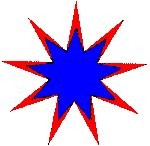

GENERATIVE ART
by Celestino Soddu (1994)
Generative art is the idea realized as
genetic code of artificial objects.
The generative project is a concept-software
that works producing three-dimensional unique and non-repeatable events
as possible and manifold expressions of the generating idea identified
by the designer as a subjective proposal of a possible world.
This Idea / human creative act renders
explicit and realizes an unpredictable, amazing and endless expansion of
human creativity. Computers are simply the tools for its storage in memory
and execution.
This approach opens a new era in design
and industrial production: the challenge of a new naturalness
of the industrial object as a unique and unrepeatable event, mirror of
the uniqueness and unrepeatability of man and nature. Once more man emulates
nature, as in the act of making art.
Argenia is the term that I have
coined for this genetic code of artificial ware that, like DNA in nature,
identifies not only an object but a species of objects. Industrial design
will no longer be the idea and realization of an object, but the idea of
a species of objects and its industrial generation.
The three-dimensional models produced
using Argenia soft, multiple results of the idea, can be directly
utilized by industrial manufacturing equipment like numerically controlled
machines and robots, which already represent the present technologies of
industrial production. This generative and automatic reprogramming
device of robots makes it possible to produce unique objects
with the same equipment and with costs comparable to those of objects that
are identical; like a printer that can produce pages that are all the same
or all different, at precisely the same cost.
Designing this artificial genetic code
was an enthusiastically creative operation. I have found myself returning
to the Renaissance cultural approach, capable of combining science and
art. I have created ideas formulating a code of the harmony that, as it
is born of the history of man and his relationship with nature, identifies
and represents my subjective vision of the possible, my imprinting as a
designer. The code of harmony, like all codes, contains some rules that
trace certain forms of behavior. Therefore it is not a sequence, a database
of events, of forms, but a definition of behavior patterns: the transformations
from what exists to to the complexity of contemporary objects in a state
of becoming. The design act changes from forming to transforming, because
each form is only one of possible parallel results of an idea.
I began this design challenge in 1987
and I have realized Generative Projects of architecture, cities, industrial
design and visions of art. Today these Argenies have become extremely
complex and directly operative as interfaces with productive systems. This
has permitted, first of all, practical experimentation such as the realization
of books that all have different covers, of unique and unrepeatable jewelry,
and of different scenarios of spaces that are incessantly transformed.
Other possibilities include computer-produced artworks that reproduce the
unrepeatable uniqueness of an artistic event, or experimentation on generative
industrial production of lamps, chairs, coffeepots.
This approach suddenly opened the possibility
to rediscover possible fields of human creativity that would be unthinkable
without computer tools. If these tools, at the beginning of the computer
era, seemed to extinguish the human creativity, today, by allowing us to
creatively, directly operate on codes of harmony, they become tools that
open new fields and enhance our understanding of creativity as an indissoluble
synthesis between art and science.
After two hundred years of the old industrial
era of necessarily cloned objects, the one-of-a-kind object becomes an
essential answer to the long-neglected human need to live a world in which
each artificial object mirrors the uniqueness and unrepeatability of every
person. In an epoch marked by repeated attempts at the cloning of natural
beings, design returns in advanced technological fields such as non-linear
dynamic systems to the notions of artificial life and artificial intelligence,
the aesthetic and ethical pleasure of rediscovering the processes and characters
of nature.